Verizon’s Unlimited Plan- Short Term Pain vs Long Term Gain
Don’t misread Verizon’s about-face on unlimited plans solely as a sign of network confidence.
Tickers: VZ, T, S, TMUS, AMT, CCI, SBAC, COMM, DY, ZAYO
Contrary to their previous explicit direction otherwise, Verizon announced on February 12th, 2017 that they would be offering an unlimited voice and data plan at rates slightly higher than comparable offerings from T-Mobile (TMUS) and Sprint (S). Not coincidentally, in its earnings call on Feb 14th, 2017, TMUS indicated that they were porting Verizon subscribers to TMUS at a 2.8:1 ratio to subscribers ported from TMUS to V. This plan is clearly slated to reduce the churn of postpaid customers from VZ to S and TMUS and we believe that it is a very compelling service offering.
Analysts were quick to choose sides: the first posited that this was a sign of VZ’s confidence in their network upgrades and capacity, while the second group believes that the network will show signs of strain under the added capacity. We believe that both groups are partially correct and that infrastructure related entities are the ones that stand to gain the most.
Back in last January, we applauded VZ for their densification efforts in our note Verizon (VZ) positioning for a range of 5G futures. The premise was simple- Verizon’s efforts to add fiber and small cells to their network give them a marked advantage over other wireless service providers in the race for 5G. That premise hasn’t changed and further research since that note continues to suggest that VZ still has a 1-2-year first-mover advantage from a US wireless infrastructure perspective.

Nonetheless, it is our opinion that VZ’s densification efforts, while industry setting, are not sufficiently complete to provide seamless and reliable service across all urban areas, especially in the near term. Verizon’s densification is based on a three-prong approach: carrier aggregation, dark fiber, and rapid deployment of small cells. On the first prong, VZ has actively deployed 2 and 3 carrier aggregation across most of the nation. On the last two prongs, while they have been leading the market in both efforts, there still are areas where their efforts have been slowed due to factors outside their controls. Based on our on-the-ground level visibility, VZ has a hefty lead in dark fiber and small cells actively deployed or in development.
In our previous note, we suggested that the next 12 to 18 months will be tough for Verizon as the impact from their investments will take time to materialize. For urban markets where VZ has encountered delays due to local zoning or permitting for deployment of small cells, there will be a reduction in reliability and data speeds. These issues will be more pronounced in markets where Verizon is relying upon two carrier aggregation.
Fortunately for VZ, these issues are surmountable and addressable, but it will take some time to rectify them. Expect to see an acceleration of densification in specific troublesome markets. Verizon will need to rely more on outside fiber and small cell providers like CCI and ZAYO. TowerCos (AMT, CCI, SBAC) should also experience continued and possibly accelerated macrocell modification activity and possibly new macrocell deployment from VZ and TMUS in their efforts to meet the pending needs of video downloads (remember that video accounted for 60% of mobile data use in 2016 and VZ and TMUS now include zero-rated HD video in their unlimited plans). Lastly, we would not be surprised to see T extend their unlimited plans beyond DirecTV subscribers, thereby further increasing densification. (Editor’s note- subsuquent to this being written, T did extend its unlimited plans beyond DirecTV subscribers.)
Risks to this note: The perception of VZ network superiority declines at a faster rate than expected, causing subscribers to question whether they should spend the additional money on VZ’s unlimited plans before VZ’s network investments reverse those issues. VZ could reverse their strategy of using outside fiber and vendors in order to control their fate by increasing CapEx towards the development of owned dark fiber assets, thereby reducing ZAYO and CCI opportunities.
(Author’s note: This research note was published first on 2/20/17. If you are interested in gaining access to our research on a timelier basis or have a discussion on this note or other wireless industry topics, please contact us.)











